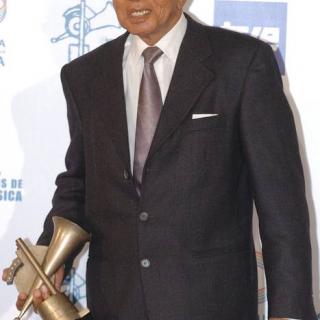
Cesar Portillo de la Luz y su guitarra
0 Follower(s)
Composer, guitarist and singer. One of the great exponents of Cuban songwriting and founder of the feeling movement.
He began his artistic career as a singer in a trio configured for guitar and tres. In those early years he was closely linked to son creation, which exerted a decisive influence on his interest in the guitar, an instrument that he played in public for the first time in 1939. In this area he learned about the first positions of the instrument; After that, he expanded his technical knowledge and put on the guitar his first chords and intervals that generate the triad, the most elementary chord that can be built. From then on he dedicated all his efforts, not only to find a suitable fingering, but also a logical explanation in the construction of chords for its later application.
Towards the end of the thirties he was very attentive to all the musical events in his context, both in the spectrum of national and foreign creation. Through the phonographic record, he closely followed the aesthetic inclinations operated in the best song of Mexico and Puerto Rico and devoted special attention to the soundtracks of North American cinema, very particularly to the orchestral work devised for the films of that cinematographic resource.
The copious auditions, both of soundtracks and phonographic records, led him to the cultivation and sedimentation of broad appreciations of an artistic nature, to the point of thinking of punctual mechanisms capable of selecting, among these musics, the melodies that he really needed for the elaboration of their own aesthetic codes. He consumed the best of Broadway musical theater music (he fell in love with the wonderful dance steps of the Ginger Rogers / Fred Astaire couple), and -thanks to the album- the fruitful musical displacement of the rich and catchy swings of swing in the style of by Benny Goodman and Glenn Miller, by the perfect rhythm experienced by bopers of the stature of Charlie Parker, Russell, Dizzie Gillespie, permeated by the Afro-Cuban percussion of Carlos Vidal and Luciano "Chano" Pozo.
Those timbres did not prevent him from appreciating the best of the potentialities of everything that was sounding then in the United States, until he reached experiences that framed singular underlines of indisputable emotion for the subsequent speech and melodic dialogue in the elaboration of the texts of his future songs. But, in reality, the greatest influence was received from Glenn Miller, who, in his musical thought, marked a mark of transcendence, especially in the timbral and harmonic aspect.
At the same time, the North American musical cinema stimulated him to undertake an approach to the Impressionist current. He gave his preferences to Claude Debussy and Maurice Ravel, for which he immediately gave himself over to long auditions with recordings such as the suite La mer, by the former, at the same time that he consumed, in a rare and voracious way, Brahms, Chopin and Liszt.
Over time, he discovered in the background music of North American musical theater and its use in musical films the existence of impressionist breaths a la Gershwing and Handy, to a greater extent than Debussy's or Ravel's impressionism itself; although in its application this music was not exempt from Impressionist codes.
So he went into the studio and audition to reaffirm many of his insights, hitherto submerged in empirical, intuitive knowledge. This led him to the decisive conviction that, although he had not achieved the systematic study of music, it was essential for him to develop his immense galaxy of concerns, and that the solution to such a complex problem was achieved through work, the only way for a artist. Through the auditions, he entered the creative world of classical and romantic composers. From each of these styles he configured his preferences from a rigorous selection.
In the 1940s, his first approaches to records recorded with the work of Manuel de Falla took place, whose compositions he would enjoy in the company of the guitarist and composer Ñico Rojas and the pianist Frank Emilio Flyn, who encouraged him to mature as a creator. However, it was only when he came into contact with professor Vicente González Rubiera that he became fully aware of the importance and complexity of the guitar.
For the composers of the feeling, the lyrics of his songs were a harvest of the emotions lived daily; with lyrics (unlike the songs of that time) close to life, to the need to exist and face realities. This in no way meant divorce from poetry, sentiment, and love of life; In contrast, these emotions were viewed from a different perspective, from a more specific poetic universe, albeit full of a lyricism far removed from morbidity and kitsch, beyond the intimate conflict of custom.